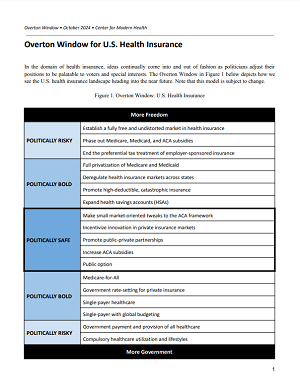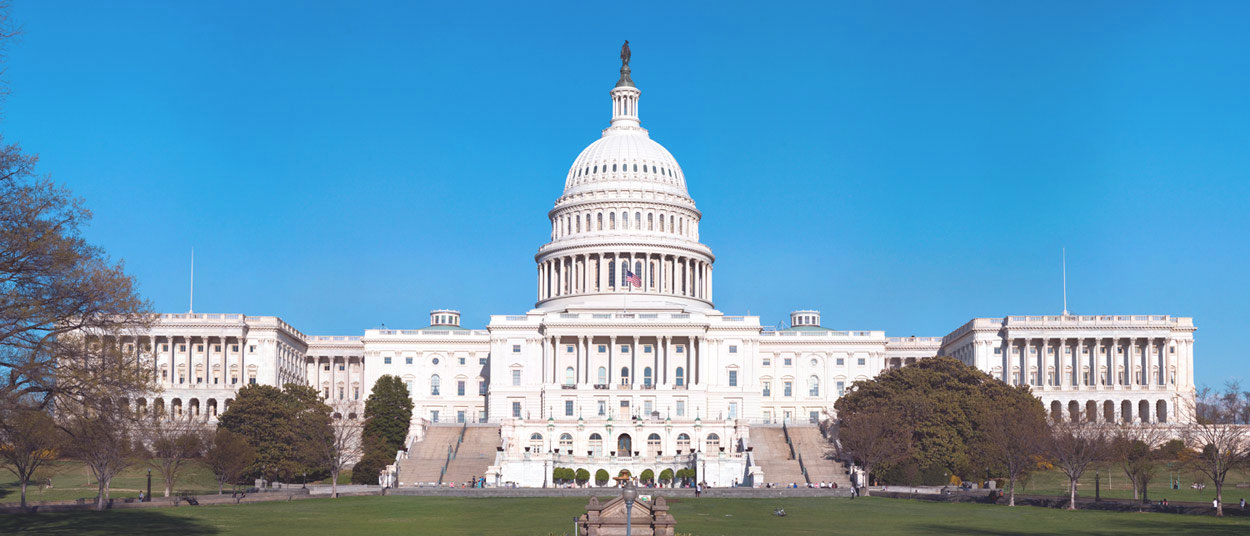Overton Window for U.S. Health Insurance
Many of the better reform ideas for health insurance policy in the U.S. remain outside the Overton Window.
View/Download [PDF]
Center for Modern Health. "Overton Window for U.S. Health Insurance." October 2024.
In the domain of health insurance, ideas continually come into and out of fashion as politicians adjust their positions to be palatable to voters and special interests. The Overton Window depicts how we see the U.S. health insurance landscape heading into the near future. Note that this model is subject to change.
The Overton Window
The Overton Window is a conceptual model developed by the Mackinac Center around the notion that at any given time there exists a continuum of conceivable policy ideas for a particular domain or issue, and it is politically safe for a politician to expressly advocate for some ideas, but not others.1 Ideas that are politically palatable to voters (i.e., carry relatively little political risk) are shown in the range labeled "Politically Safe." Ideas within this range are said to be "within the Overton Window." (To be clear, an idea being within the Overton window does not necessarily mean that it is a good idea; it merely means that it is not politically risky.)
As the reader moves either up or down the model—i.e., toward greater freedom or less freedom—the policy ideas become more politically risky for politicians to express, and therefore one can expect to find fewer politicians willing to express them. "Politically Bold" ideas carry a moderate amount of political risk, sometimes because they entail a substantial departure from the status quo. "Politically Risky" ideas carry a high amount of political risk, usually because they entail a still bigger or more radical change. (Other practitioners use different labels for these ranges but the basic idea is the same.)
The order of ideas as they appear in the continuum generally does not change, but the Overton Window can be thought of as both movable and resizable. Through advocacy, education, research, coalition building, and other activities, the Overton Window can slide up or down the continuum, and it can also become wider or narrower with changes in the political climate.
U.S. Health Insurance
Explanations of ideas along the health insurance policy continuum:
Politically Risky & Towards More Freedom
- Establish a fully free and undistorted market in health insurance. This would require the elimination of all coverage mandates, regulations, and distortions of the health insurance market. Insurers would compete to design the best products and win over consumers on elements such as value, service, and price.
- Phase out Medicare, Medicaid, and ACA subsidies. This would gradually phase out the major governmental programs that are involved in providing or subsidizing health insurance. Seniors and low-income individuals would be served by insurers that design policies to profitably meet the needs of those consumers. Individuals obtain private coverage on the individual market or through an employer, or pay for care out of pocket (i.e., self-insure).
- End the preferential tax treatment of employer-sponsored insurance. End the tax advantage given to employer-provided health insurance, as a way to give employees more freedom over how they spend their healthcare dollar. This would help to bring about a new individualized market in insurance, contrary to the status quo which is substantially driven by group plans.2
Politically Bold & Towards More Freedom
- Full privatization of Medicare and Medicaid. Transition government programs into private-sector equivalents with means-tested voucher systems or premium support. The government could lift restrictions on how Medicare Advantage plans can market themselves, or change administrative details such as by making Medicare Advantage the default choice (i.e., opt-out, instead of opt-in) for new enrollees.
- Deregulate health insurance markets across states. Allow individuals to purchase insurance across state lines, reducing regulatory barriers. People trapped in states with regulatory regimes that favor special interests over consumers can shop for insurance that better fits what they desire.
- Promote high-deductible, catastrophic insurance. High-deductible, catastrophic coverage typically comes with low monthly premiums. It is a sensible option for some people, particularly people who do not intend to utilize a lot of services. Exempting them from having to cover all "essential health benefits" could make them even more attractive to some people.
- Expand health savings accounts (HSAs). This would increase tax benefits and contribution limits to encourage private saving for healthcare. The new HSA contribution limit for 2025 will be $4,300 for self-only health coverage, up from $4,150 in 2024. Additional increases could be made to make this a more consumer-friendly option.
Politically Safe
- Make small market-oriented tweaks to the ACA framework. This would preserve the Affordable Care Act but find minor ways to reduce mandates and increase flexibility. These changes could include reducing the number of mandated "essential benefits," letting private insurance exercise slightly more selectivity around applicant age and health status, and lengthening the allowable duration of short-term renewable plans.
- Incentivize innovation in private insurance markets. This would promote approaches like value-based insurance design (VBID). A goal of VBID is to minimize or eliminate out-of-pocket costs for high-value services in defined patient populations, to encourage smarter utilization. It is an efficiency tweak that has been extended to Medicare Advantage organizations through 2030.3
- Promote public-private partnerships (PPPs). This arrangement leverages private insurers to manage portions of Medicare or Medicaid. Medicare Advantage is the arrangement whereby private insurers cover the same services as fee-for-service (FFS) Medicare and offer additional benefits. About 54 percent of the eligible Medicare population enrolls in a Medicare Advantage plan.4 Medicaid PPPs are used to reach eligible populations and enroll them in state Medicaid programs. This does little to reduce the size or influence of government, but to some extent does enhance consumer choice.
- Increase ACA subsidies. This would increase government subsidies to make insurance more affordable for more people. The Affordable Care Act (ACA) subsidies have been strengthened through the American Rescue Plan Act (ARPA) and the Inflation Reduction Act (IRA), which extended the enhanced subsidies through 2025. Congress will have to act to extend them.
- Public option. This would introduce a government-run health insurance plan to compete alongside plans offered by private insurers. Efforts to enact a public option at the federal level have floundered for years, but interest in creating state-level public options is on the rise.5
Politically Bold & Towards More Government
- Government rate-setting for private insurance. This would mandate that private insurers pay hospitals and providers in accordance with government-determined reimbursement rates. A "price" for each medical procedure would be determined through some non-market mechanism, and that would be the one price that all health insurers pay. The idea is to increase efficiency and reduce administrative overhead.6 Rates would be reviewed and updated from time to time.
- Medicare-for-All. Extend Medicare to all citizens but allow supplemental private insurance for additional coverage. Whereas a public option might be funded by individuals or partially through taxes, Medicare-for-All could be entirely government-funded and government-run. Past attempts at Medicare-For-All bills have proposed automatic enrollment upon birth or residency, and cover all services that are "medically necessary or appropriate to maintain health."7 This would prohibit cost-sharing (e.g., deductibles) for covered services. Finally, private health insurers likely would only be allowed to offer supplemental (non-duplicative) coverage. This is bold but not without support; around 50 percent of Americans believe that healthcare is a government obligation.8
- Single-payer healthcare. This would bring about a full nationalization of the health insurance industry, eliminating private health insurance entirely. Under a single-payer system, all healthcare services and procedures are paid for by the government, funded through taxes. An ideal of egalitarians, a single-payer healthcare system would bring about universal coverage for all Americans. Administrative savings, it is claimed, would help to pay for this major expansion.9 Patients would be promised to receive all medically necessary care.
- Single-payer with global budgeting. This would institute a single-payer system (see above), but with the addition of nationwide caps on healthcare spending with strict government oversight and rationing. Efficiency is the main argument for adding the global budgeting component.10 Hospitals and other healthcare providers would be paid for the care that they deliver, until the allocated funds for a given time period (e.g., the current year) have been used. Once spending has reached the budgeted amount, care would be denied, delayed, limited, or rationed in some way.
Politically Risky & Towards More Government
- Government payment and provision of all healthcare. Under this reform, the federal government not only would pay for all Americans' healthcare (fully taking over the insurance/payer role), it would also be the entity that provides all care and services. In other words, all physicians and healthcare providers would be federal employees. Private-sector involvement in healthcare would be prohibited and eliminated entirely. As a comparison, this would be similar to England's National Health Service (NHS), but even more closely controlled. (In England, many General Practitioners are considered self-employed contractors. In an absolutely fully government system, they would be direct government employees.)
- Compulsory healthcare utilization and lifestyles. Going even beyond the payment and provision of care, in a system of extreme government involvement, the government would compel individuals' medical decisions and lifestyle choices to reduce public healthcare costs. This could include mandated vaccinations, treatments, diets, or exercise. Few people hold this as an ideal system, however the greater the extent to which society makes itself responsible for paying for everyone's medical care, the greater the extent to which it will have an interest in each person's lifestyle and behavior as it contributes to the health of the nation.11
Summary
The proposals included in this document represent just some of the many policy options that are alive in today's discourse on U.S. health insurance. Concerningly, the window is getting wider at the bottom margin (i.e., in the direction of greater government involvement) more quickly than at the top. Once considered a "bold" proposal, support of a Public Option is no longer a particularly risky position for politicians to hold. Similarly, Medicare-For-All was once considered "risky," but arguably is now merely a bold position for a politician to hold.
Overton Window practitioners often recommend first building support for ideas that are inside the window, before moving onto bolder ideas that are outside the window. Advocates of free markets and individual rights may first need to work through making market-oriented tweaks to the ACA and then quickly moving on to HSA and high-deductible health plan promotion unless new politicians enter the scene soon who are willing to support bolder deregulations—or better yet but more risky—ending the preferential tax treatment of employer-sponsored insurance.
References:
1. "The Overton Window" Mackinac Center for Public Policy. Accessed October 30, 2024.
2. Center for Modern Health. "Flatten the Tax Treatment of Health Insurance." August 2024.
3. "Medicare Advantage Value-Based Insurance Design Model Extension Fact Sheet" Centers for Medicare and Medicaid Services. March 23, 2023.
4. Freed, et al. "Medicare Advantage in 2024: Enrollment Update and Key Trends" Kaiser Family Foundation. August 8, 2024.
5. Monahan, et al. "State Public Option Plans Are Making Progress on Reducing Consumer Costs" The Commonwealth Fund. November 7, 2023.
6. Anderson and Herring. "The All-Payer Rate Setting Model for Pricing Medical Services and Drugs" AMA J Ethics. Aug 2015.
7. "Medicare For All Act" S.1655; 118th Congress (2023-2024).
8. Brenan, M. "Majority in U.S. Still Say Gov't Should Ensure Healthcare" Gallup. January 23, 2023.
9. Reinhardt, U. "Why single-payer health systems spark endless debate" BMJ. 2007 Apr 28;334(7599):881.
10. Yang, et al. "The Impact of Global Budgeting on the Efficiency of Healthcare under a Single-Payer System in Taiwan" Int J Environ Res Public Health. 2021 Oct 19;18(20):10983.
11. Keys, B. "The Body as a Political Space: Comparing Physical Education under Nazism and Stalinism" German History, Volume 27, Issue 3, July 2009, Pages 395-413.
